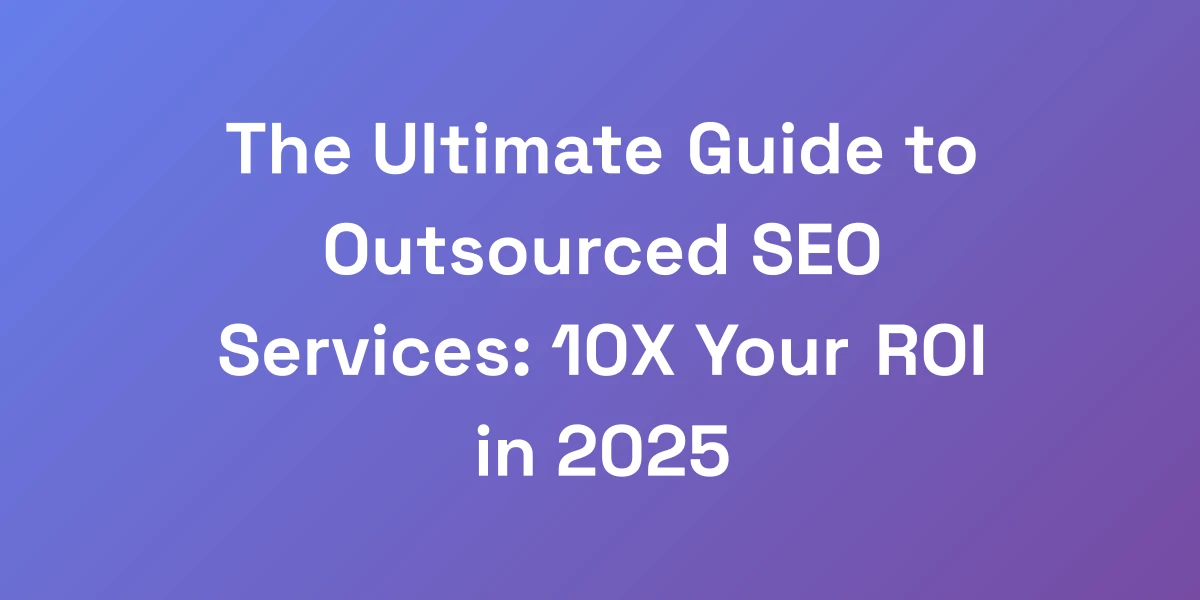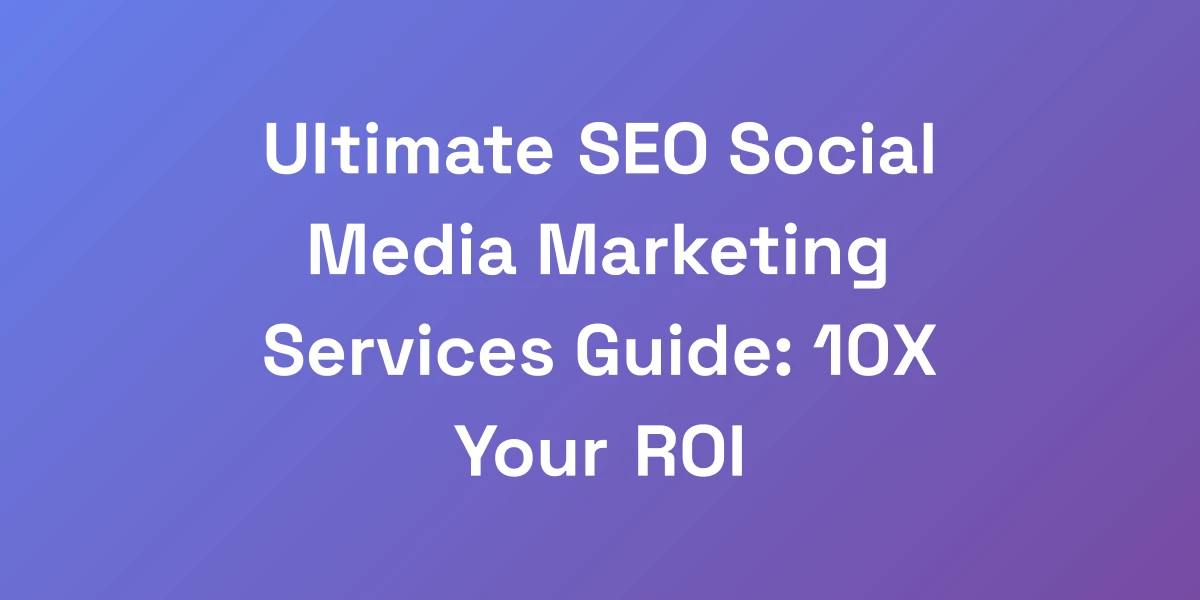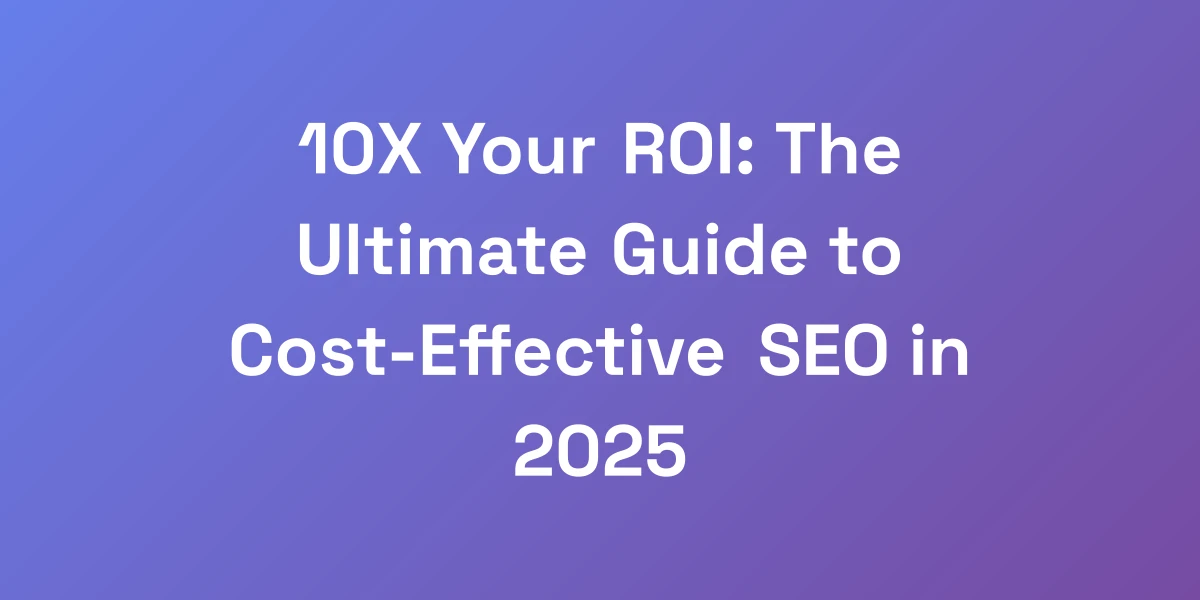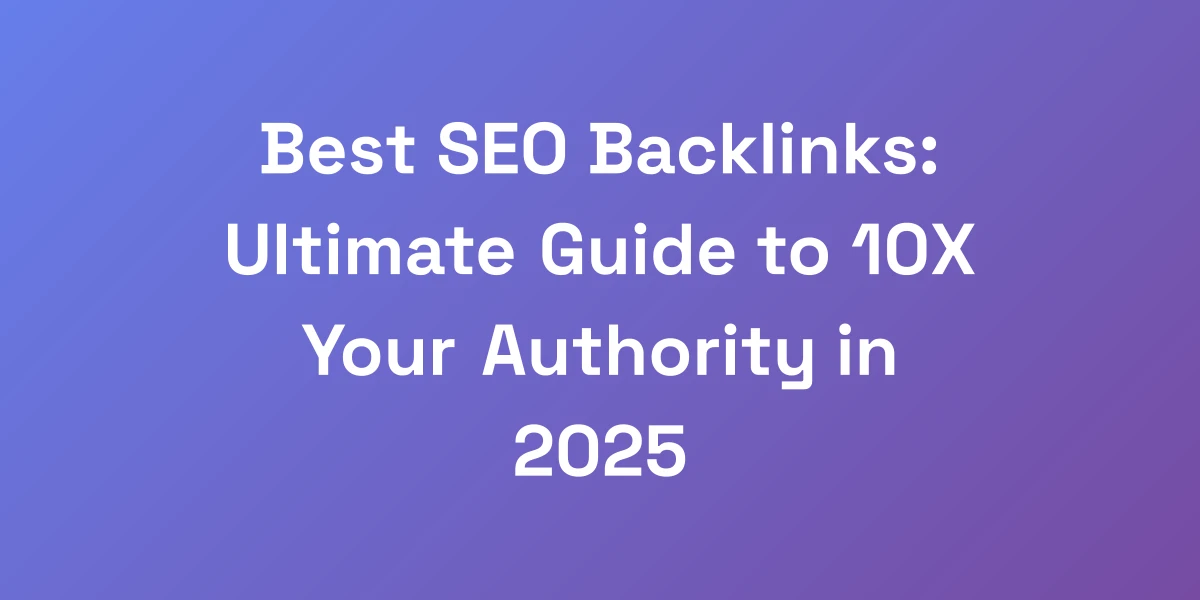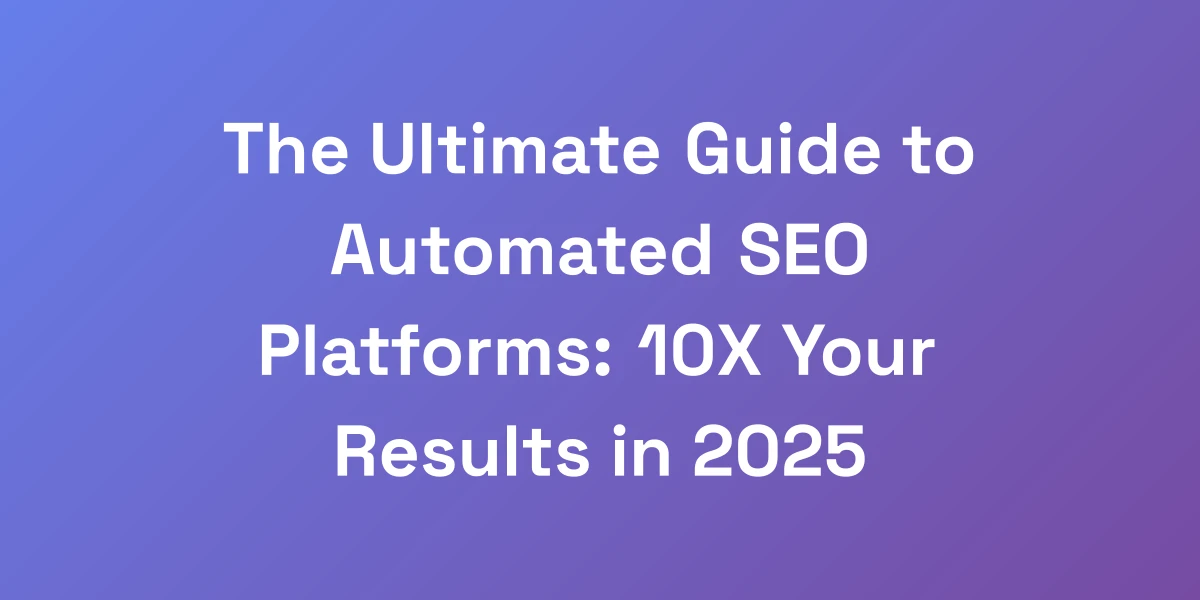
Ultimate SEO Marketing Packages Guide: 10X Your ROI in 2025
Mar 27, 2025 | By [email protected]
Introduction
Let’s cut to the chase: SEO marketing packages are either your secret weapon or your biggest money sink. We’ve all seen businesses throw cash at SEO, hoping for a miracle. Spoiler alert? Most end up with nada.
Why? Because they’re not choosing the right packages that align with their goals. They’re stuck in a cycle of spending without seeing real results. It’s frustrating, right?
Imagine pouring thousands into a system that doesn’t understand your business. It’s like investing in a sports car and never taking it out of the garage. What’s the point?
In this guide, we’ll dismantle the typical SEO package debacle. We’re here to show you how to pick and perfect SEO packages that actually 10X your ROI in 2025. Ready to transform your strategy? Let’s get started.
Why Most Businesses Waste Money on the Wrong SEO Packages
Let me hit you with some truth: 83% of businesses are hemorrhaging SEO cost on SEO packages that don’t deliver. I’ve seen companies dump thousands into “premium” packages that were nothing but smoke and mirrors. Here’s the reality – your SEO package isn’t just a service, it’s an investment vehicle. And just like any investment, if you don’t know what you’re buying, you’re gambling, not growing. In this guide, I’m going to show you exactly how to select and leverage SEO packages that actually move the needle for your business.
The Hidden Costs of Cheap SEO Packages
Cheap SEO packages might seem like a bargain, but they’re often riddled with hidden costs that can drain your budget without delivering results.
- Low-Quality Content: These packages frequently include poorly written content that fails to engage or convert.
- Ignored Technical SEO: Vital elements like site speed, mobile optimization, and secure connections are often neglected.
- Subpar Link Building: Cheap SEO services may use black-hat tactics, risking penalties from search engines.
- Lack of Transparency: Hidden fees and unclear reporting make it difficult to track what you’re actually paying for.
Remember, what you see isn’t always what you get. A low upfront cost often masks the true expenses you’ll incur in the long run.
Why Premium Doesn’t Always Mean Better Results
Spending more doesn’t automatically translate to better SEO results. Premium packages can be overpriced if they don’t align with your specific needs.
- One-Size-Fits-All Approach: Many premium packages offer generic solutions that don’t cater to your unique business requirements.
- Overemphasis on Expensive Tools: High cost doesn’t guarantee effective tool utilization. It’s about strategy, not just tools.
- Engagement in Irrelevant Niches: Premium packages might include services that your business doesn’t need, wasting resources.
- Relationship Overload: More expensive packages often come with more touchpoints, which can dilute focus and effectiveness.
Instead of just going for the top dollar, focus on packages that are precisely tailored to drive your specific business goals.
The Real Metrics That Define SEO Package Success
Success isn’t measured by how much you spend but by the results you achieve. Here are the true metrics to evaluate your SEO packages:
- Organic Traffic Growth: Are you seeing a consistent rise in visitors from search engines?
- Keyword Rankings: Are your targeted keywords moving up in the search results?
- Conversion Rates: Is the increased traffic translating into leads or sales?
- Return on Investment (ROI): Are you getting more revenue than what you’re spending on SEO?
- Engagement Metrics: Metrics like bounce rate, time on site, and pages per session indicate the quality of traffic.
Focusing on these metrics ensures that your SEO efforts are aligned with your business objectives and delivering tangible value.
Common Package Selection Mistakes to Avoid
Choosing the wrong SEO package can set your business back. Here are common pitfalls to watch out for:
- Ignoring Specific Needs: Selecting a package based solely on price without considering your unique requirements.
- Overlooking Agency Expertise: Not evaluating the agency’s track record in your industry. For agency-specific strategies, see digital marketing for agencies.
- Failing to Ask for Transparency: Not insisting on clear, detailed reporting makes it hard to track progress.
- Neglecting Long-Term Strategy: Choosing providers focused only on quick wins rather than sustainable growth.
- Underestimating the Importance of Communication: Poor communication can lead to misaligned goals and ineffective strategies.
Avoid these mistakes by thoroughly vetting your options and ensuring they align with your strategic objectives.
Understanding Your True SEO Needs
Your SEO needs are unique to your business. To choose the right package, first, you need to understand what those needs actually are related to digital marketing and SEO. For small businesses, digital marketing for small businesses requires specific strategies tailored to their unique needs and budget constraints.
- Business Goals: Define what you want to achieve with SEO – more traffic, higher conversions, better brand awareness?
- Current SEO Status: Assess your website’s current SEO health to identify gaps and opportunities.
- Target Audience: Understand who you’re trying to reach and what they’re searching for.
- Competitive Landscape: Analyze what your competitors are doing and where you can differentiate.
- Budget Constraints: Determine how much you’re willing to invest in SEO to shape your package choices.
By clarifying these aspects, you can tailor your SEO package to meet your specific business needs effectively.
Breaking Down SEO Marketing Package Components
Stop getting confused by fancy package names and flashy promises. Here’s what actually matters: the core components that drive real business results with a solid SEO strategy for 2024. I’ve generated over $100M in revenue for my clients, and I can tell you that effective SEO packages aren’t about checking boxes – they’re about strategic implementation. Let me break down the exact elements that should be in your SEO package and why they matter to your bottom line.
Essential Technical SEO Elements
Technical SEO forms the foundation of your website’s search performance. Without it, content and marketing efforts can go to waste.
- Site Speed Optimization: Fast-loading sites improve user experience and search rankings.
- Mobile Optimization: With mobile-first indexing, your site must perform seamlessly on all devices.
- Secure Sockets Layer (SSL): Security is critical for trust and ranking, so HTTPS is a must.
- XML Sitemaps and Robot.txt: Proper sitemaps and robot files ensure search engines can crawl and index your site effectively.
- Structured Data: Implementing schema markup helps search engines understand your content better and enhances visibility in rich snippets.
- Canonical URLs: Prevent duplicate content issues by specifying preferred URLs.
Investing in these technical aspects ensures your website is search-engine friendly and ready to rank higher.
Content Creation and Optimization Services
Content is king, but only if it’s high-quality and optimized. This is where the magic happens.
- Keyword Research: Identifying the right keywords to target your audience effectively.
- Content Strategy: Developing a plan that aligns with your business goals and audience needs.
- High-Quality Content: Creating engaging, informative, and valuable content that ranks and converts. For automated content creation strategies, explore autoblogging.
- On-Page Optimization: Ensuring each page is optimized with appropriate keywords, meta tags, and headers.
- Content Audits: Regularly reviewing and updating content to maintain relevance and performance.
A robust content strategy not only drives traffic but also establishes your authority in the industry.
Link Building and Authority Development
Building a strong backlink profile is crucial for SEO success. It’s about quality, not quantity.
- Guest Posting: Publishing articles on reputable sites to gain high-quality backlinks.
- Broken Link Building: Identifying broken links on other websites and offering your content as a replacement.
- Skyscraper Technique: Creating superior content to attract backlinks naturally.
- Local Citations: Listing your business on local directories to boost local SEO and gain backlinks.
- Relationship Building: Cultivating relationships with influencers and industry leaders for natural link opportunities.
Effective link building enhances your site’s authority and improves search engine rankings.
Local SEO Components
For businesses targeting local markets, local vs national SEO is indispensable. It ensures you’re visible to customers in your vicinity.
- Google My Business Optimization: Claiming and optimizing your listing to appear in local searches.
- Local Keyword Targeting: Focusing on keywords that include your location to attract local traffic.
- Online Reviews: Managing and encouraging positive reviews to enhance your local reputation.
- Local Citations: Consistently listing your business information across various local directories.
- Localized Content: Creating content that addresses local events, news, and activities relevant to your audience.
These strategies make your business more discoverable to local customers, driving foot traffic and sales.
Analytics and Reporting Features
Without proper tracking, you can’t measure success. Analytics and reporting are critical for informed decision-making.
- Google Analytics Integration: Tracking website traffic, user behavior, and conversion metrics.
- Keyword Ranking Reports: Monitoring your rankings for targeted keywords over time.
- Backlink Analysis: Keeping track of your backlink profile and identifying new opportunities.
- Performance Dashboards: Visual representations of key SEO metrics for easy analysis.
- ROI Tracking: Measuring the return on your SEO investment to ensure profitability.
Comprehensive reporting allows you to see what’s working and what’s not, enabling continuous optimization. Additionally, leveraging automated SEO tools can streamline your analytics and reporting processes.
Implementation Timeline and Deliverables
Success hinges on timely execution and clear deliverables. Here’s what you should expect:
- Initial Audit: A thorough analysis of your current SEO status to identify strengths and weaknesses.
- Strategic Planning: Developing a customized SEO strategy based on the audit findings.
- Phased Implementation: Executing the strategy in manageable phases, ensuring quality and effectiveness.
- Regular Updates: Providing consistent updates on progress and adjustments as needed.
- Final Deliverables: Clear, tangible outcomes such as improved rankings, increased traffic, and higher conversions.
Having a well-defined timeline and clear deliverables keeps the SEO process on track and accountable.
How to Calculate the True ROI of SEO Packages
Here’s the brutal truth about SEO package pricing: it’s not about what you pay, it’s about what you get back. I’ve seen $500 packages outperform $5,000 ones because they were better aligned with business objectives. Let me show you my measure ROI for SEO. We’ll cut through the BS and focus on the numbers that actually matter to your business growth.
Setting Realistic ROI Expectations
Before diving into calculations, set realistic expectations. SEO is a long-term game, and immediate results are rare.
- Understand the Timeline: SEO efforts typically take several months to show significant results.
- Define Success Metrics: Clearly outline what success looks like for your business – whether it’s increased traffic, higher sales, or improved brand visibility.
- Benchmarking: Use current performance metrics as a baseline to measure growth accurately.
- Adjust Goals: Be prepared to adjust your ROI expectations based on ongoing performance and industry trends.
Realistic expectations ensure that you stay motivated and informed throughout your SEO journey.
Tracking and Measuring SEO Package Performance
Accurate tracking is key to measuring your SEO ROI. Here’s how to do it right:
- Set Up Google Analytics 4 (GA4): Integrate GA4 to monitor visitor behavior, conversions, and other vital metrics.
- Use SEO Tools: Tools like Ahrefs and Semrush help track keyword rankings and backlink profiles.
- Regular Reporting: Schedule consistent reports to review progress and make informed decisions.
- Monitor Traffic Sources: Identify which traffic comes from organic search and how it contributes to conversions.
- Analyze User Behavior: Look at metrics like bounce rate, time on site, and pages per session to assess engagement.
Comprehensive tracking provides a clear picture of your SEO performance and identifies areas for improvement.
Short-term vs Long-term Value Assessment
SEO delivers both immediate and sustained benefits. Understanding this dual value is crucial for accurate ROI assessment.
- Short-term Gains: Initial traffic boosts from optimizations like on-page SEO and technical fixes.
- Long-term Benefits: Sustainable growth through continuous content creation, backlink building, and authority development.
- Balancing Efforts: Allocate resources to both short-term wins and long-term strategies for maximum impact.
- Evaluating Progress: Monitor both immediate changes and ongoing improvements to gauge overall success.
This balanced approach ensures that your SEO strategy supports both quick wins and enduring growth.
Hidden Value Multipliers in SEO Packages
Beyond direct metrics, SEO packages often include value multipliers that significantly enhance your ROI.
- Brand Authority: Improved rankings enhance your brand’s credibility and trustworthiness.
- Customer Insights: SEO analytics provide valuable data on customer behavior and preferences.
- Marketing Synergy: SEO complements other marketing efforts, such as content marketing and social media, amplifying overall effectiveness.
- Competitive Advantage: A robust SEO strategy can set you apart from competitors, giving you a market edge.
These hidden value multipliers often play a crucial role in overall business growth and should be considered when calculating ROI.
Red Flags in ROI Promises
Be wary of SEO packages that make unrealistic ROI promises. Here’s what to watch out for:
- Guaranteed Rankings: No one can guarantee #1 rankings due to the unpredictability of search engine algorithms.
- Instant Results: SEO is a gradual process; beware of packages promising immediate success.
- Over-Promising Services: Packages that promise a wide range of services without a clear focus often lack depth.
- Ambiguous Metrics: Vague claims about performance improvements without specific metrics are a red flag.
- Lack of Transparency: If the provider doesn’t clearly explain how they’ll achieve results, it’s best to steer clear.
Protect your investment by ensuring that SEO providers set realistic, transparent expectations.
Customizing SEO Packages for Maximum Impact
Cookie-cutter SEO packages are dead. Period. In today’s market, you need a package that’s tailored to your specific business objectives. I’m going to show you how to choose the right SEO package for your industry. This isn’t theory – these are the exact strategies I’ve used to help businesses scale from six to seven figures through strategic SEO implementation. Let’s talk about real customization that drives real results.
Identifying Your Business’s Unique SEO Needs
Every business is different, and your SEO strategy should reflect that. Here’s how to identify your unique SEO needs:
- Business Goals: Are you aiming for brand awareness, lead generation, or sales conversions?
- Target Audience: Who are your customers, and what are they searching for?
- Industry Competition: How competitive is your industry in terms of SEO?
- Current SEO Performance: What’s working and what’s not in your current strategy?
- Budget Allocation: How much can you realistically invest in SEO without compromising other areas?
Understanding these factors allows you to tailor your SEO package to meet your specific business needs effectively.
Scaling Packages as You Grow
Your SEO needs will evolve as your business grows. Here’s how to scale your SEO packages accordingly:
- Initial Phase: Focus on foundational SEO elements like technical optimization and basic keyword targeting.
- Growth Phase: Expand to content creation, advanced link building, and broader keyword targeting as you scale.
- Maturity Phase: Invest in ongoing SEO maintenance, advanced analytics, and continuous content updates to sustain your growth.
- Flexible Budgeting: Adjust your SEO budget based on performance metrics and business growth.
- Advanced Strategies: Incorporate advanced tactics like voice search optimization, AI-driven content, and comprehensive user experience enhancements.
Scaling your SEO efforts in line with your business growth ensures sustained success and maximized returns.
Industry-Specific Customization Strategies
Different industries require different SEO strategies. Here’s how to customize your SEO package based on your industry:
- E-commerce: Focus on product page optimization, structured data for better visibility, and high-converting landing pages.
- Local Services: Emphasize local SEO tactics like Google My Business optimization, local keyword targeting, and managing online reviews.
- Healthcare: Prioritize content that builds authority, patient education, and compliance with industry regulations.
- Real Estate: Invest in local SEO, high-quality listings, and virtual tour optimizations to attract potential buyers.
- Finance: Ensure secure site infrastructure, authoritative content, and compliance with financial regulations.
Tailoring your SEO strategies to your industry nuances ensures that your efforts are both effective and compliant with sector-specific regulations.
Combining Different Package Elements
To achieve maximum impact, you need to combine various SEO elements strategically. Here’s how to do it:
- Integrate Technical and Content SEO: Ensure your technical foundation supports your content strategy for seamless performance.
- Align Link Building with Content Strategy: Use content as a tool to earn high-quality backlinks naturally.
- Merge Local and National SEO: If relevant, balance both strategies to capture local and broader market audiences.
- Combine Analytics with Strategy Adjustment: Use data from analytics to refine and enhance your SEO strategies continually.
- Synergize with Other Marketing Channels: Align SEO efforts with social media, email marketing, and paid ads for a cohesive strategy.
This integrated approach ensures that all SEO components work synergistically, enhancing overall effectiveness and driving better results.
Negotiating Custom Package Terms
Negotiating the right terms for your customized SEO package is crucial. Here’s how to approach it:
- Clearly Define Your Goals: Clearly communicate your business objectives and desired outcomes to the SEO provider.
- Request Transparent Pricing: Ensure all costs are transparent and there are no hidden fees.
- Set Performance-Based Milestones: Establish clear performance milestones tied to specific results.
- Flexibility in Services: Negotiate the ability to add or remove services as your needs evolve.
- Contract Terms: Ensure contract terms are favorable and allow for adjustments based on performance.
By negotiating effectively, you can create an SEO package that perfectly aligns with your needs and maximizes your investment.
Implementation and Success Metrics
Listen up: the best SEO package in the world is worthless without proper implementation and tracking. I’m going to give you my proven framework for ensuring your SEO package delivers results. We’re talking about concrete metrics, real-time adjustments, and the exact KPIs that matter. No fluff, no vanity metrics – just pure, actionable data that drives business growth.
Setting Up Tracking Systems
Accurate tracking is the backbone of measuring SEO success. Here’s how to set it up:
- Install Google Analytics 4 (GA4): GA4 is essential for tracking website traffic, user behavior, and conversion metrics.
- Set Up Google Search Console: Monitor your site’s presence in Google search results and identify indexing issues.
- Implement SEO Tools: Use tools like Ahrefs and Semrush for in-depth keyword tracking and backlink analysis.
- Configure Conversion Goals: Define and set up conversion goals in GA4 to track specific user actions.
- Utilize Tag Management: Use Google Tag Manager to manage and deploy tracking codes efficiently.
These systems provide the data you need to monitor performance and make informed decisions.
Monthly Performance Benchmarks
Setting monthly benchmarks helps you stay on track and measure progress consistently.
- Traffic Growth: Track monthly increases in organic traffic to gauge overall performance.
- Keyword Ranking: Monitor the progression of your targeted keywords in search results each month.
- Conversion Rates: Measure the rate at which visitors complete desired actions, such as purchases or sign-ups.
- Backlink Acquisition: Keep an eye on the number and quality of backlinks earned each month.
- Engagement Metrics: Analyze metrics like bounce rate, time on site, and pages per session for user engagement insights.
Regularly reviewing these benchmarks ensures you’re consistently working towards your SEO goals.
Adjusting Strategy Based on Results
SEO is dynamic, and your strategy needs to adapt based on performance data.
- Identify Trends: Look for patterns in your data to understand what’s working and what’s not.
- Test and Iterate: Implement A/B testing for different strategies and refine approaches based on results.
- Optimize Content: Update and improve underperforming content to boost rankings and engagement.
- Refine Keyword Strategy: Adjust your keyword focus based on changing search behaviors and competition.
- Enhance Technical SEO: Continuously improve site speed, mobile usability, and other technical aspects.
Being flexible and responsive to data ensures your SEO strategy remains effective and relevant.
Communication with Your SEO Provider
Effective communication with your SEO provider is essential for success.
- Regular Updates: Schedule consistent check-ins to discuss progress and any necessary adjustments.
- Clear Reporting: Demand clear, detailed reports that outline performance and next steps.
- Feedback Loop: Provide constructive feedback to help your provider align their efforts with your goals.
- Collaboration: Work together on strategy adjustments to ensure mutual understanding and commitment.
- Transparency: Maintain an open line of communication to address any concerns or questions promptly.
Strong communication fosters a productive partnership and ensures your SEO efforts are always aligned with your objectives.
Long-term Success Indicators
Beyond immediate metrics, focus on long-term indicators that signify sustainable SEO success.
- Consistent Traffic Growth: Steady increases in organic traffic over time.
- High-Quality Backlinks: A growing portfolio of authoritative and relevant backlinks.
- Strong Domain Authority: Increasing your domain authority as a measure of your site’s overall strength.
- User Engagement: Improved metrics like time on site and lower bounce rates indicating better user experience.
- Revenue Growth: Direct correlation between SEO efforts and increased sales or leads.
These indicators ensure that your SEO strategy is not just effective but also sustainable for long-term business growth.
Conclusion
We’ve navigated the murky waters of SEO marketing packages, uncovered the truths behind wasted investments, and laid out a roadmap for selecting and customizing packages that deliver real results. Remember, SEO isn’t a magic wand, but with the right strategy, it can be your most powerful growth tool.
By understanding your unique needs, focusing on the right metrics, and maintaining strong communication with your SEO provider, you can ensure that your investment not only pays off but truly 10X your ROI in 2025.
Ready to take control of your SEO strategy and watch your business soar? Start by auditing your current SEO efforts, choose the right package, and tailor it to suit your goals. Your future self will thank you.
What challenges have you faced with SEO packages? Share your experiences and strategies in the comments below, and let’s grow together.
